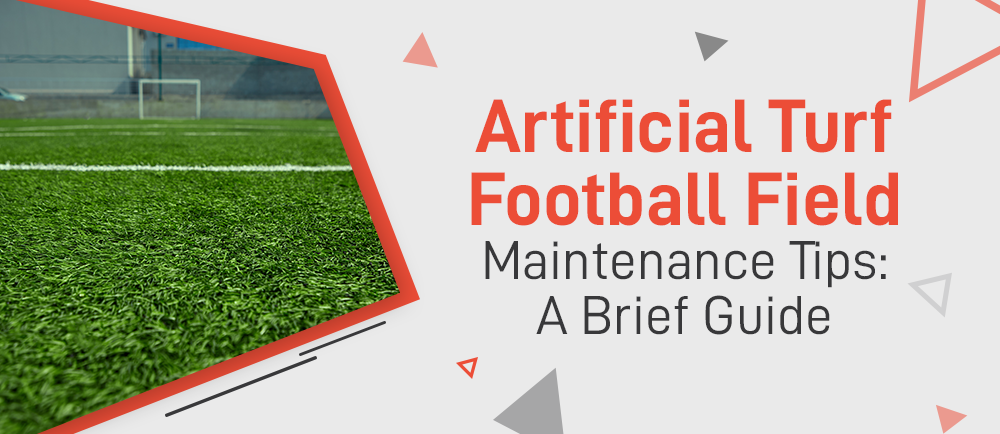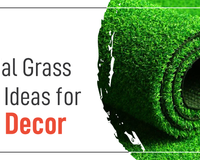Artificial turf football fields are a lifesaver for many. They not only offer a beautiful landscape but are a great alternative for home games, community events, or even pep rallies. For many, they are an excellent substitute to deal with the tiring maintenance of a grass field.
However, that does not imply that artificial fields do not come with a few rules of maintenance for themselves. Artificial turfs require consistent upkeep, thereby enabling the field to last several years longer. But where to begin with the maintenance activities? Not sure what sort of maintenance is required to maintain the longevity of artificial turf?
Well, we have curated a list of several tips to keep your synthetic turf as clean and safe as possible. Consider these tips when planning your next upkeep strategy.
Why Maintain Artificial Turf Football Fields?
1. Aesthetics
The artificial turf can withstand any harsh wear, without losing its original look. This makes it a plausible choice. With regular testing, followed by proper cleaning and maintenance, the artificial turf can be secured in the long run. By timely investing in artificial grass maintenance and repair, sports clubs can benefit from excellent artificial grass quality.
2. Safety
Artificial turf pitches can be used several times and in almost any weather. Players, coaches, and groundskeepers are aware that the training sessions are particularly demanding on an artificial pitch. A significant example of one of the standard situations is that a specific area of the pitch is often put under more strain than others during football training. However, artificial grass only withstands regular training sessions, but it is also resistant to rain, snow, UV radiation, dust, falling seed pods, and other environmental factors.
3. Longevity
The framework of the artificial turf represents real progress when gaining a greater understanding of the importance of regular and specialist maintenance. This helps in preserving the artificial turf for a longer duration, irrespective of the number of activities undertaken on the surface.
Looking for a Premium Artificial Turf Supplier for your football pitch?
Get a Free Quote today & Let Our Experts Help with Your Project Needs.
Maintenance Tips
1. Regular cleaning to get rid of stains
There is a common misconception about synthetic turf that it is 100 percent impervious to any type of stain. But that is not the case. While it certainly is true for elemental items like dirt, water, and sand, artificial turf still requires protection from several things that can leave a stain. These stains can be due to animal waste that occurs on the field, blood from an injury during a football game, or a stain from some type of debris.
The trick is to eliminate these stains as soon as they are formed. The longer the stains are left there, the more they will ingratiate into the fibres. When removing the stain, make sure to use as much hot water and soap as possible. Otherwise, try sticking to carrying around a bucket of hot soapy water to scrub the stain with a sponge. Don't forget to do a spot check after every major sporting event.
2. Picking up debris frequently
The care of an artificial turf football field or turf requires consistency. Take pride in maintaining the quality of the artificial field’s synthetic fibres by removing anything that is likely to tarnish it over time. One of the peskiest aspects is to make sure the field is free of any debris. It is important to have a maintenance crew to undertake a thorough clean-up of the turf after all major events in the field. This helps to ensure that the quality of the turf stays intact.
3. Sanitation and disinfection
Regular maintenance of the artificial turf football field installation is important to get rid of debris. A vacuum or leaf blower can be used to clean up dirt, seeds, or snow in the winter. This type of cleaning can be mitigated by restricting the use of gum, tobacco, sunflower seeds, and other sharp objects. An abundance of trash cans can also be placed around the facility to avoid any loitering on the turf.
Beyond surface cleaning, the artificial turf should also be sanitised on a weekly or monthly basis to protect the health of players as well as the coaches. This disinfection requires the use of special solvents, cleansers, and anti-microbial products. They help in getting rid of any invisible particles and bacterial growth.
4. Watering to reduce the temperature of the field on hot days
Heat can detriment the turf. Depending on where you live, while consistent heat can be hard to avoid, one important activity to undertake is to water the turf to reduce the temperature on hot days. Anytime there is an irregularly hot spring or summer day, ensure to water the turf down to cool it off a bit. That will help to fight off some of the heat trapped in the turf.
5. Undertake regular repairs
While a majority of synthetic turf field maintenance can be completed through regular practices and diligence, some of the issues do require professional help. It is therefore important to ensure that the synthetic sports turf is ready for optimal and safe play. The right turf maintenance involves patching, cleaning, and grooming the field. With professional help, it becomes easier to maintain the field. It helps treat the dragging carpet fibres or measure the field’s hardness. Learn more about our synthetic turf with UrbanCart.
Basic Practices to Protect the Artificial Turf
- The hardness of the artificial turf should be measured periodically to ensure that the level of hardness is less than the 200 Gmax level.
- Sweeping and dragging the turf helps in keeping the carpet fibres in the upright position. Once a week or once a month the turf should be swept depending on use.
- Loosening and redistributing of infill is advisable to enhance the footing, reduce the formation of static electricity, and improve the look of the field. The fields should be groomed before every game.
- It is important to check and replenish the infill level, especially in high-use areas. The infill leads to the creation of padding and shock absorption for the synthetic turf system. This helps in restoring the field’s resiliency. It takes around 20 tons of crumb rubber to provide a ¼ inch layer.
- Use a vacuum or leaf blower to get rid of any debris such as sunflower seeds.
- After each game, clean the turf with special solvents or cleansers.
- Treat the turf with anti-microbial products to get rid of any bacterial growth.
- Don't forget to remove snow during winter months.
Final Thoughts
Now that you are aware of the several ways to maintain the synthetic turf field, it’s time to place an order with the right installer for your needs and that is UrbanCart. For further inquiries about artificial turf football field installation, get in touch with our team and they will be happy to assist you further!




